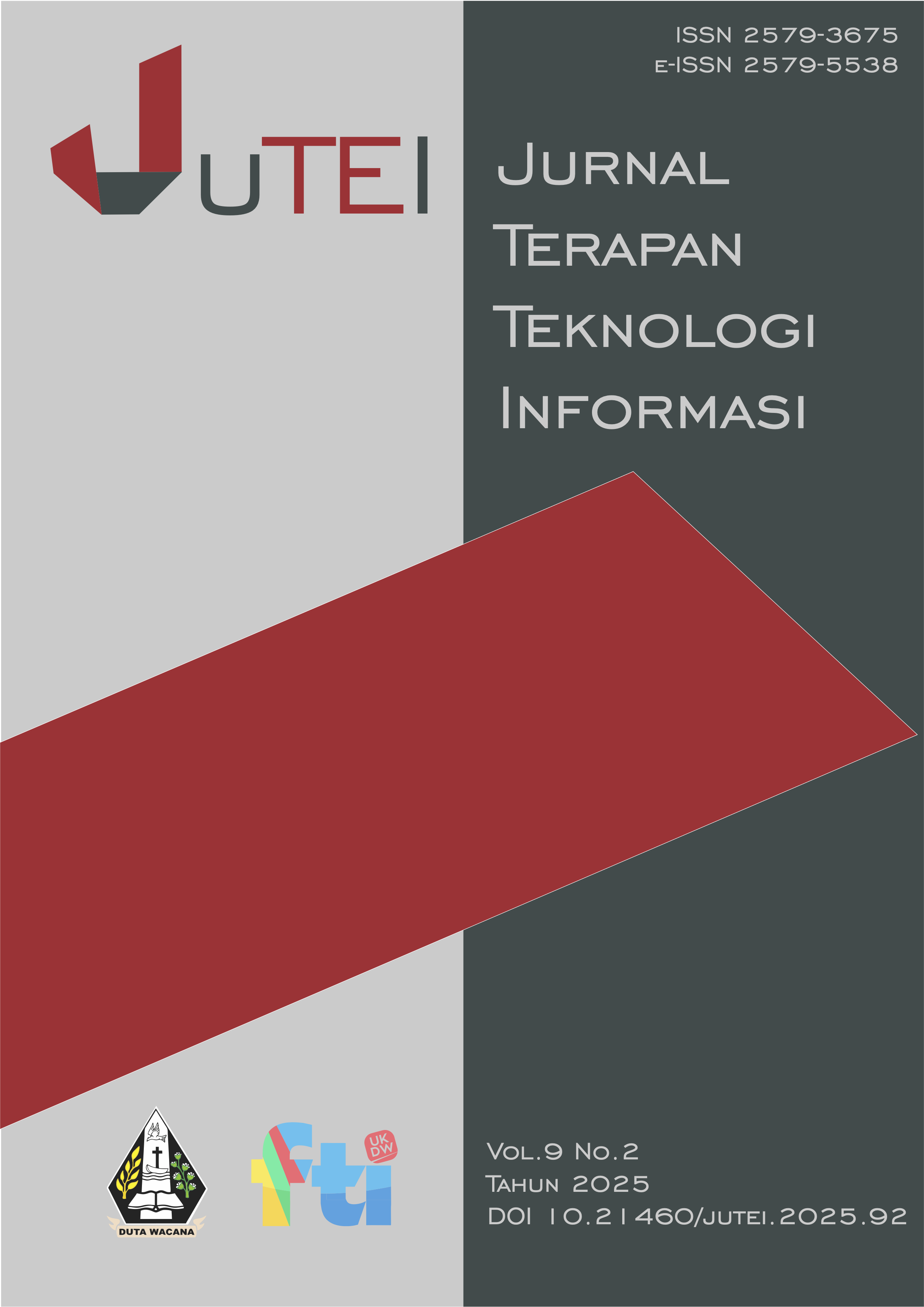Analisis Deret Waktu Aktivitas Communication Log pada Sistem Penerimaan Mahasiswa
DOI:
https://doi.org/10.21460/jutei.2025.92.435Keywords:
digital communication, university admission system, time series analysis, user interaction, system logAbstract
Digital communication analysis within university admission systems plays a crucial role in understanding the effectiveness of interactions between prospective students and the integrated admission platform. This study aims to analyse the time series patterns of communication activities recorded in the admission system’s communication logs from two years. A quantitative descriptive time series approach was employed, focusing on the frequency of activities based on daily, weekly, and hourly intervals, as well as calculating the time differences between logs to measure user interaction intensity and response speed.
The results indicate a significant increase in communication activity prior to the enrolment period, with the highest frequency observed in Week 41 of 2021 and Week 3 of 2022. The analysis of time differences between logs reveals noticeable variations in user behaviour, where some applicants demonstrated long interaction gaps, while others exhibited high and continuous system engagement. These variations highlight differences in user involvement levels during the digital communication process within the admission stages.
This study contributes to a deeper understanding of user interaction patterns in integrated admission systems and serves as a basis for developing strategies to enhance user experience through optimized notifications, adaptive system responsiveness, and interface designs tailored to user behavior.
References
A. Marks, M. Al-Ali, R. Atassi, A. Z. Abualkishik, and Y. Rezgui, “Digital Transformation in Higher Education: A Framework for Maturity Assessment,” 2020. [Online]. Available: www.ijacsa.thesai.org
G. Bucăţa, F. Popescu, and C. Tileagă, “Digital Transformation of Higher Education System,” International conference KNOWLEDGE-BASED ORGANIZATION, vol. 28, no. 1, pp. 158–168, Jun. 2022, doi: 10.2478/kbo-2022-0025.
C. J. Arizmendi et al., “Predicting student outcomes using digital logs of learning behaviors: Review, current standards, and suggestions for future work,” Behav Res Methods, vol. 55, no. 6, pp. 3026–3054, Sep. 2023, doi: 10.3758/s13428-022-01939-9.
J. E. S. Carmo, D. P. Lacerda, C. O. Klingenberg, and F. A. S. Piran, “Digital transformation in the management of higher education institutions,” Jun. 01, 2025, Elsevier Ltd. doi: 10.1016/j.sftr.2025.100692.
N. N. Muhamad and H. Thamrin, “Analyzing and Forecasting Admission data using Time Series Model,” Jurnal Online Informatika, vol. 5, no. 1, pp. 35–44, Jul. 2020, doi: 10.15575/join.v5i1.546.
J. Saint, Y. Fan, D. Gašević, and A. Pardo, “Temporally-focused analytics of self-regulated learning: A systematic review of literature,” Jan. 01, 2022, Elsevier B.V. doi: 10.1016/j.caeai.2022.100060.
C. Li, T. Yu, H.-T. Fan, G. Xiao, J. Arinez, and Q. Chang, “Manufacturing Letters Dynamic Bottleneck Identification and Production Loss Evaluation for Assembly Lines,” 2023. [Online]. Available: www.sciencedirect.com
J. B. Cândido, M. F. Aniche, and A. van Deursen, “Log-based software monitoring: a systematic mapping study,” Mar. 2021, [Online]. Available: http://arxiv.org/abs/1912.05878
S. Oladele, “Investigating the Impact of Big Data on Data-Driven Decision-Making.” [Online]. Available: https://www.researchgate.net/publication/387365278
D. Seebacher, M. T. Fischer, R. Sevastjanova, D. A. Keim, and M. El-Assady, “Visual Analytics of Conversational Dynamics,” May 2021, doi: 10.2312/eurova.20191130.
V. Kuleto, “Privacy and Ethics in Web Analytics: Balancing User Data and Ethical Considerations.” [Online]. Available: www.ijbmm.com
F. Sadegh Vaziri, A. Shoja, B. Osanlou, M. Simorgh, and J. Homepage, “Identification; Examining the Role of Cultural Orientation (Collectivism / Individualism) Curriculum and instruction perspective journal (CIPJ),” CIPJ, vol. 1, no. 1, 2021, doi: 10.22034/cjpj.2021.13626.
J. S. Flaviano, “Decentralization of communication: practices and challenges of integrated schools in Roxas City,” 2025.
S. Helmi, B. Setyadi, and D. Aryasari, “Strategy of the School Principal in Increasing the Quality of Humanistic Perspective Human Resources Management,” QALAMUNA: Jurnal Pendidikan, Sosial, dan Agama, vol. 15, no. 1, pp. 111–124, Mar. 2023, doi: 10.37680/qalamuna.v15i1.2225.
S. Lorenzen, N. Hjuler, and S. Alstrup, “Tracking Behavioral Patterns among Students in an Online Educational System,” Aug. 2019, [Online]. Available: http://arxiv.org/abs/1908.08937
F. Chen and Y. Cui, “Utilizing student time series behaviour in learning management systems for early prediction of course performance,” Journal of Learning Analytics, vol. 7, no. 2, pp. 1–17, Sep. 2020, doi: 10.18608/JLA.2020.72.1.
Z. Pi, Y. Zhang, Q. Yu, and J. Yang, “A familiar peer improves students’ behavior patterns, attention, and performance when learning from video lectures,” International Journal of Educational Technology in Higher Education, vol. 20, no. 1, Dec. 2023, doi: 10.1186/s41239-023-00418-1.
S. Mao et al., “Time Series Analysis for Education: Methods, Applications, and Future Directions,” Aug. 2024, [Online]. Available: http://arxiv.org/abs/2408.13960
M. Clement, “Cost Optimization and Performance Efficiency in Multi-Cloud Workload Orchestration.” [Online]. Available: https://www.researchgate.net/publication/388527102
Prinafsika, A. Junaidi, and M. Muharrom Al Haromainy, “Cloud-Based High Availability Architecture Using Least Connection Load Balancer and Integrated Alert System,” bit-Tech, vol. 8, no. 1, pp. 263–274, Aug. 2025, doi: 10.32877/bt.v8i1.2520.
S. Bosnjak and A. Sakah, “Web Performance Optimization and Its Impact on User Experience and Development Practices.” [Online]. Available: www.bth.se
H. Choi, J. E. Lee, W.-J. Hong, K. Lee, M. Recker, and A. Walker, “Exploring Learning Management System Interaction Data: Combining Data-driven and Theory-driven Approaches.”
Downloads
Published
How to Cite
Issue
Section
License
Copyright (c) 2025 Kristina Wulandari

This work is licensed under a Creative Commons Attribution-NonCommercial-NoDerivatives 4.0 International License.
Authors who publish articles in JUTEI agree on the following rules:
1. The author grants non exclusive royalty free rights, and is willing to publish articles online and complete (full access). With such rights JUTEI reserves the right to save, transfers, manages in various forms, maintains and publishes articles while keeping the author's name as the copyright owner.
2. Each author contained in the article has contributed fully to the substance and intellectual, and is accountable to the public. If in the future there is a copyright infringement notification then this will be responsibility of the author, not JUTEI.







